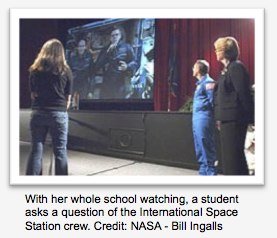 NASA has launched its first multi-player online game totest players’ knowledge of the space program. Who was the firstAmerican to walk in space? Who launched the first liquid-fueledrocket? These are only a few of the questions players can answer inSpace Race Blastoff.
NASA has launched its first multi-player online game totest players’ knowledge of the space program. Who was the firstAmerican to walk in space? Who launched the first liquid-fueledrocket? These are only a few of the questions players can answer inSpace Race Blastoff.
Available on Facebook, Space Race Blastoff tests players’ knowledge ofNASA history, technology, science and pop culture. Players whocorrectly answer questions earn virtual badges depicting NASAastronauts, spacecraft and celestial objects. Players also earnpoints they can use to obtain additional badges to complete sets andearn premium badges.
“Space Race Blastoff opens NASA’s history and research to a wide newaudience of people accustomed to using social media,” said DavidWeaver, NASA’s associate administrator for communications. “Spaceexperts and novices will learn new things about how explorationcontinues to impact our world.”
NASA chose to make the game available through Facebook to takeadvantage of the social media site’s large audience and enableplayers to compete against others. Individuals also can play sologames.
Once in the game, players choose an avatar and answer 10multiple-choice questions. Each correct answer earns 100 points, witha 20-point bonus to the player who answers first. The winner advancesto the bonus round to answer one additional question for more points.
Correctly answering the bonus question earns the player a badge.
Space Race Blastoff was developed by Scott Hanger, Todd Powell andJamie Noguchi of NASA’s Internet Services Group in the Office ofCommunications. Play the game now at http://apps.facebook.com/spacerace
Link to the NES Virtual Campus home page.

 Through innovative partnerships with commercial rocket and spacecraft developers, NASA is making great strides to advance America’s next human space transportation systems.
Through innovative partnerships with commercial rocket and spacecraft developers, NASA is making great strides to advance America’s next human space transportation systems. NASA has launched its first multi-player online game totest players’ knowledge of the space program. Who was the firstAmerican to walk in space? Who launched the first liquid-fueledrocket? These are only a few of the questions players can answer inSpace Race Blastoff.
NASA has launched its first multi-player online game totest players’ knowledge of the space program. Who was the firstAmerican to walk in space? Who launched the first liquid-fueledrocket? These are only a few of the questions players can answer inSpace Race Blastoff.  This resource presents the electromagnetic spectrum by introducing how we interact with these waves on a daily basis and how NASA scientists use the unique qualities of each wavelength to study the sun, planets and origins of the universe. EM waves measured by Earth-observing satellites help NASA scientists understand our Earth system and changing global patterns and climate.
This resource presents the electromagnetic spectrum by introducing how we interact with these waves on a daily basis and how NASA scientists use the unique qualities of each wavelength to study the sun, planets and origins of the universe. EM waves measured by Earth-observing satellites help NASA scientists understand our Earth system and changing global patterns and climate. During Expeditions 31 and 32, crew members aboard the International Space Station will participate in downlinks. Downlinks are approximately 20 minutes in length and allow students and educators to interact with astronauts through a question and answer session. Downlinks afford education audiences the opportunity to learn firsthand from astronauts what it is like to live and work in space. Downlinks are broadcast live on NASA TV and are streamed on the NASA website. Because of the nature of human spaceflight, organizations must demonstrate the flexibility to accommodate changes in downlink dates and times.
During Expeditions 31 and 32, crew members aboard the International Space Station will participate in downlinks. Downlinks are approximately 20 minutes in length and allow students and educators to interact with astronauts through a question and answer session. Downlinks afford education audiences the opportunity to learn firsthand from astronauts what it is like to live and work in space. Downlinks are broadcast live on NASA TV and are streamed on the NASA website. Because of the nature of human spaceflight, organizations must demonstrate the flexibility to accommodate changes in downlink dates and times.